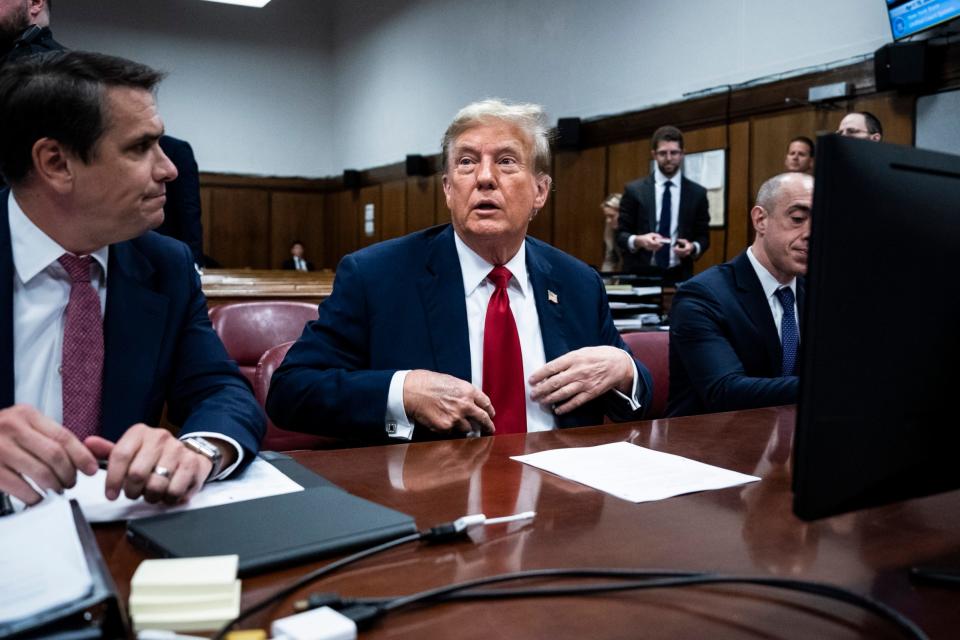How they'll decide: Read the jury instructions for the historic Trump hush-money trial

Trump's jury has only the verdict sheet and a laptop full of exhibits in the deliberations room.
They must check the boxes for "Not Guilty" or "Guilty" on 34 counts of falsifying business records.
They will not have a copy of the judge's hour-long, spoken instructions on the underlying law.
After four weeks of testimony by nearly two dozen witnesses — plus hundreds of exhibits and eight hours of closing arguments — the first-ever criminal trial of a former US president now has a deliberating jury.
Donald Trump's potential criminal record rests in the hands of seven men and five women, a majority white-collar group that includes three men with finance backgrounds and two men who are lawyers.
Jurors listened intently for just over an hour Wednesday morning — with several taking brief notes — as the judge described the law to them before sending them to a deliberations room adjacent to the courtroom.
Jurors had to surrender their cellphones to the safe-keeping of court officers before beginning their work.
"I'm going to ask you to step out now and begin your deliberations," New York Supreme Court Justice Juan Merchan told the jury as parting words at 11:28 a.m.
Two jurors — a man who works as a security engineer, and a woman who works as a software engineer — volunteered to learn to operate the laptop on which they can view trial exhibits while deliberating.
The laptop contains no other data and is not connected to the internet.
Finally, six alternates — five women and one man — were asked to wait in a separate room. "There might be a need for you at some point in the deliberations," the judge told them.
The jury is returning Thursday morning to continue their deliberations after receiving a read-back of about 35 pages of testimony they requested from the judge, as well as hearing the instructions again.
Here are the documents that will guide the Trump jury's decisions in New York's historic hush-money trial.
The verdict sheet
The verdict sheet is the only hard-copy document the jurors will have with them in the deliberations room. It instructs them to check "Not Guilty" or "Guilty" on each of 34 counts of a single charge: falsifying business records in the first degree.
Each of the 34 counts pertains to a different invoice, check, and ledger entry that Trump allegedly caused to be entered into the Trump Organization's business records throughout 2017, his first year in office.

Falsifying business records in the first degree

Prosecutors say Trump caused 34 business records to be falsified as part of an illegal conspiracy to influence the 2016 election.
The records, prosecutors say, disguised the true purpose of $130,000 in "legal fee" reimbursements paid throughout 2017 to Trump's then-lawyer, Michael Cohen.
In reality, Cohen was being secretly reimbursed for his hush-money outlay to Stormy Daniels, a payment that silenced the porn star just 11 days before the 2016 election, prosecutors allege.
Merchan read to jurors from the standard jury charge for felony falsifying business records.

The jury charge
New York Supreme Court Justice Juan Merchan spent more than an hour Wednesday morning speaking to jurors, slowly describing to them the laws that will underpin their verdict.
Read the judge's "jury charge" here.
During the charge, Merchan warned jurors to be on guard against any "implicit bias" about groups of people and the defendant himself.
They were also reminded that prosecutors bear the burden of proving guilt beyond a reasonable doubt, and that they must consider only testimony, exhibits, and attorney stipulations in reaching a verdict — not the potential for punishment.
"The defendant is not required to prove that he is not guilty," he reminded jurors. "The defendant is not required to prove or disprove anything."
Finally, the jurors were instructed on the underlying laws, and their definitions.
Key among these laws is section 17-152 of the New York election law. Business Insider described this important but rarely-used state election-conspiracy law last month.
To convict, jurors must find that Trump falsified business records to conceal an attempt to violate 17-152.
And to find that Trump attempted to violate 17-152, jurors must find he attempted to commit any of three additional underlying offenses. These are the federal election campaign-finance law, an additional New York business-falsification law, and a violation of tax laws on either a city, state or federal level.
The judge told jurors that they could not take a written copy of the charge with them to the deliberations room.
"You may however request I read them back to you in whole, or in part, as many times as you wish," he told them. "And I will be happy to do so."
The defense lawyers, prosecutors, and Trump himself were instructed not to leave the courthouse during deliberations.
Trump sat still during the judge's instructions Wednesday, leaning back in his chair and closing his eyes, leaving his hands in his lap. On at least one occasion, he appeared to stretch in his seat.
Once Merchan sent the jurors to the deliberation room, Trump appeared relaxed — even jovial — joking with his son, Donald Trump, Jr., as he left the courtroom to await his verdict.
Once in the hallway, he huddled with his aides outside the courtroom for three minutes before walking up to the cameras and complaining about the judge.
This story has been updated.
Read the original article on Business Insider


